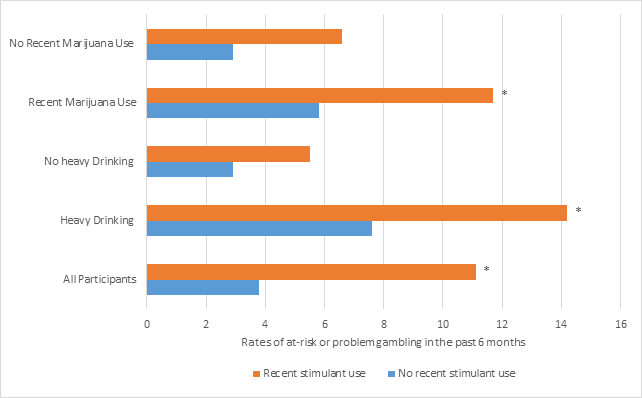Since 2008, more college students have reported using prescription drugs like Adderall, Ritalin and Concerta. These types of drugs stimulate the brain and make people with attention disorders like ADD or ADHD more focused; however, some students misuse these medications in order to get a high or to boost academic performance. With the rise of non-medical use of prescription drugs, it is important to understand how this behavior fits within college students’ other typical risky behaviors, such as gambling. Recently, researchers led by Irene Geisner studied the relationship between stimulant use and gambling behavior among college students. This week, as part of our Special Series on Gambling and Addiction, the STASH reviews their study.
What was the research question?
Is there a relationship between stimulant use and gambling among college students?
What did the researchers do?
The researchers randomly recruited 10,062 college students. Of those students, 4640 completed an online survey that included questions about their demographics, gambling habits, alcohol use, and other substance use. Geisner and her colleagues also followed a sample of particularly at-risk students who completed a gambling prevention trial; however, we are not describing those results here.
What did they find?
Among the sample of 4,640 students, those who had recently used stimulants had higher rates of recent gambling-related problems than participants who did not (11.1% vs. 3.8%). The researchers controlled for demographic characteristics and risk factors and still found that participants who recently used stimulants were 74% more likely to report problem gambling. The relationship between stimulant use and problem gambling held when the researchers looked at two subgroups of participants: those who reported heavy drinking or recent marijuana use. But, this relationship did not hold true for those who did not report these behaviors (see Figure).
Why do these findings matter?
College students are at risk for numerous harmful behaviors (e.g., binge drinking) and dangerous consequences. It is important to identify the different risk factors that contribute to risky behavior. These results suggest that college students who use stimulants are especially at risk for gambling problems and might need targeted interventions.

Figure. Rates of at-risk or problem gambling in the past 6 months. Click image to enlare.
Every study has limitations. What about this one?
The researchers did not determine if participants were gambling and using stimulants simultaneously (i.e. using stimulants while gambling) or concurrently (i.e. doing both, but not at the same time). Students could have different motives for simultaneous versus concurrent use and could experience different kinds of consequences. This is an avenue for future research.
For more information:
If you or a loved one has a problem with gambling please visit the first steps to change here.
For information and help with substance use please click here.
— Alec Conte
What do you think? Please use the comment link below to provide feedback on this article.




